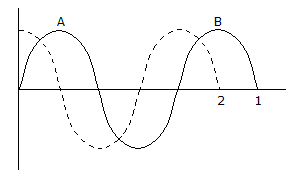Discussion
Home ‣ Civil Engineering ‣ Elements of Remote Sensing Comments
- Question
The phase difference of the waves 1 and 2 at A in the given figure is :

Options- A. ?/4
- B. ?/2
- C. ?
- D. 3?/2
- Correct Answer
- ?/2
- 1. The spectral region of the electromagnetic radiation which passes through the atmosphere without much attenuation is known as:
Options- A. ozone hole
- B. atmospheric window
- C. ozone window
- D. black hole Discuss
- 2. Which one of the following errors is produced by platform characteristics of the sensor?
Options- A. altitude variation
- B. altitude
- C. orbit drift
- D. All of these Discuss
- 3. A roadstead :
Options- A. is a protected area of water where boats can move safely
- B. is the end of the road at the harbour
- C. may be protected by break water walls
- D. none of these. Discuss
- 4. Depth of borings for soil investigation, is generally kept below low water level
Options- A. 30 m
- B. 35 m
- C. 45 m
- D. 40 m Discuss
- 5. Pick up the incorrect statement from the following:
Options- A. As a wave of sea water approaches the coast line, it is generally accompanied by a drift of water in the direction of wave advance
- B. The on-shore wind helps to produce wave action as well as rise of M.S.L.
- C. A falling hydraulic gradient occurs in the direction of the wave
- D. The wave while receding carries finer particles out to deep water. Discuss
- 6. If 0 is the angle of scan measured from the nadir, the ground distance swept by the sensor IFOV is proportional to :
Options- A. sin2?
- B. cos2?
- C. sec2?
- D. tan2? Discuss
- 7. Pick up the correct statement from the following :
Options- A. When the electric field oscillates in the direction of the electric vector, a plane polarised wave is formed.
- B. When the electric vector is in the plane of incidence, vertical polarisation is formed.
- C. When the electric vector is at right angles to the plane of incidence, horizontal polarization wave is formed.
- D. The plane containing the incident ray and normal to the reflecting surface at the point of incidence is called the plane of incidence.
- E. All of these Discuss
- 8. The entire range of the electromagnetic spectrum spans a large spectrum of wave lengths varying from:
Options- A. 10-10 to 106 m
- B. 10-8 to 106 m
- C. 10-10 to 1010 m
- D. 10-8 to 108 m Discuss
- 9. The arrangement of terrain features which provides attributes: the shape, size and texture of objects, is called :
Options- A. spectral variation
- B. spatial variation
- C. temporal variation
- D. None of these . Discuss
- 10. Remote sensing techniques makes use of the properties of-----emitted, reflected or diffracted by the sensed objects:
Options- A. electric waves
- B. soundwaves
- C. electromagnetic waves
- D. wind waves Discuss
Elements of Remote Sensing problems
Search Results
Correct Answer: atmospheric window
Correct Answer: All of these
Correct Answer: is a protected area of water where boats can move safely
Correct Answer: 45 m
Correct Answer: A falling hydraulic gradient occurs in the direction of the wave
Correct Answer: sec2?
Correct Answer: All of these
Correct Answer: 10-10 to 106 m
Correct Answer: spatial variation
Correct Answer: electromagnetic waves
Comments
There are no comments.More in Civil Engineering:
Programming
Copyright ©CuriousTab. All rights reserved.
